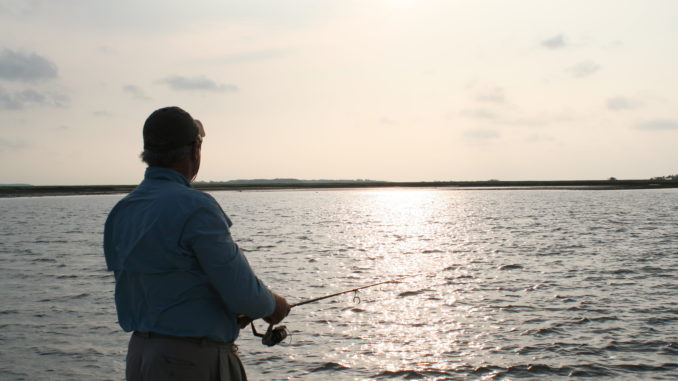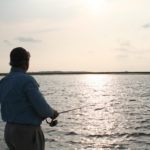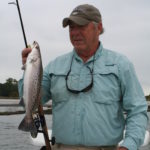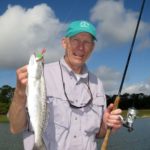
Pay attention to current and tide and you’re halfway to locating a gold-mine of South Carolina speckled trout this month.
Speckled sea trout fed all summer on the plentiful prey, but they were hard to find because they don’t like hot weather and hide in deeper water during the day, foraging early and late. That changed in September, and by this month, some urgency has been added to their feeding patterns as winter approaches. They are schooled and feeding throughout the day. They move around as the tide changes, but if you find a school in November, you will likely have a banner day.
Danny Rourke of Beaufort’s Tailwind Charters has been fishing Lowcountry waters around Beaufort all his life, but he admits that he really didn’t know much about speckled trout until he began guiding in 2002. Now, he knows that November is a good time to leave redfish behind and concentrate on trout, and he knows the real trick is finding them.
Rourke looks for specks in moving but clean water, knowing that trout dirty water that has been silted up with sand and pluff mud. He searches on high and falling tidal water, drifting along banks, focusing on water seams or lines emanating from small tidal creeks coming out of the marsh. These water lines can stretch out fairly far into deep water; he works them from shallow to deep with a D.O.A. shrimp or similar bait by swimming it out with the current. He said most strikes occur close to the shallows, but trout can hold in water a lot deeper than many people think, even as deep as 10 to 12 feet.
On rising water Rourk often works banks with a cork rig baited with shrimp or mud minnows. His choice is a Cajun Thunder cork and a No. 1 Kahle hook with a split shot crimped on about 8 inches above the bait. He will drift the cork rig along grass lines so the bait is suspended just above the submerged shells, constantly adjusting the depth as the tide rises or falls.
For anglers trying to find trout on their own, he suggests doing research at low tide and picking a single bank in a likely trout holding spot, often referred to a “trout drop” or drop-off. There is just too much water in our area to try to learn it all, so pick a smaller area and learn it well. Drift along at low tide and make a mental note or even enter GPS waypoints for oyster shell outcroppings, likely holding spots for trout when the water covers them. Then go back with the rising tide and float a cork over the shells with the bait almost touching the bottom. Work the area over and over in the rising water and notate where you get strikes and the water depth. Do that on a few more outings and you are on your way to catching trout consistently.
“The best tides are when there is a half moon where the low tides aren’t very low and the high tides aren’t very high,” Rourk said, explaining that the moving waters is generally much clearer under those conditions. Search for fish with float and mud minnow or shrimp or by swimming a jig with a minnow.
Rourk uses and recommends for most inshore situations a medium-light Temple Fork spinning rod with a 2500 series Shimano Stradic reel spooled with 10-pound braid, with a 3-foot section of 20-pound fluorocarbon leader when he’s casting jigs or topwater plugs.
Bait is still pretty plentiful in November, so Rourk throws a cast net for shrimp or sets a trap for mud minnows, two of his favorite trout baits. He uses the Blue Coat Creek area on the lower Broad River as an example of an area with a sandy bottom and generally clean water where casting a mud minnow on a jighead and slowly swimming it back along the bottom is an effective technique. Many other similar areas are in the Broad River.
Richard Sykes, who guides out of Bay Street Outfitters in Beaufort, said he clients often forgo trips for redfish in November because of the relatively easy pickings on schooling trout.
“Trout relate to edges, points and oysters, and many spots are water-, depth- and tide-specific,” he said. “Just because a spot was good last week at 11 o’clock on a rising tide does not mean fish will be there today at 11 o’clock on a falling tide. If you don’t find fish in 10 minutes or so, keep moving.”
Sykes looks for trout moving in and out of areas as the availability of food and the water depth changes. He counts on points and oyster bars with current, upcurrent and downcurrent sides of major creek mouths and grass edges, especially where oysters break the current flow.
Trout prefer 3 to 4 feet of water and will often remain in an area for a while before moving on. Sykes agrees with Rourk that the most-productive times to catch trout are from half-tide rising through the first our after high tide. He sticks with popping- cork rigs with live shrimp for customers but often switches to a jighead with a Gulp! trailer when the local shrimp thin out later in November and on into December.
Sykes fishes light-action spinning outfits spooled with 15-pound braid. If he or his clients are casting and retrieving instead of drifting a popping-cork rig, he’ll go with a 1/8- to 1/4-ounce jighead with a Gulp! or some other scented trailer, his favorite of late being a Trout Trick.
Jigs and trailer offerings will catch both trout and reds, aka spot-tail bass, with the difference being the depth of water targeted and speed of the retrieve. Sykes does say that a hookset on a trout should be a more gentle, sweeping motion rather than the powerful strike used to hook spot-tails. Trout have much-softer mouths.
The waters around Beaufort contain thousands of prime acres in St. Helena and Port Royal sounds and the Broad and Beaufort rivers. Enough public ramps are spread around the area to make access relatively easy, and good fishing is often found close to boat ramps.
The shoreline to the left of Jenkins Creek Landing on St. Helena Island is a good spot for trout, and the stretch of the Morgan River across from Dataw Island Marina is another. The mouth of Fish Creek across the Coosaw River from Sam’s Point landing can be productive, and from there, it’s a short run to fish the northern shoreline across from Pigeon Point in Beaufort. From Station Creek Landing on St. Helena Island, good flats on both sides of the river green anglers where the Story River meets Trenchard’s Inlet.
The Chechessee River landing at the SC 170 bride allows fishermen access to the Broad Rivers. Expansive flats on the river’s southern shoreline between Boyd Creek and Hazzard Creek have numerous oyster outcroppings. Upstream of the bridge, flats off Corn Island are also productive, as are creek mouths downstream from the bridge on the northern shoreline, especially Blue Coat Creek.
DESTINATION INFORMATION
WHEN TO GO/HOW TO GET THERE — The four hours from mid-tide rising until an hour after high tide is prime time to catch speckled trout in the waters around Beaufort in November, which is a peak month for trout fishing. US 21 is the prime route off I-95 to the Beaufort area. The Chechessee River landing at the foot of the SC 170 bridge provides great access to fishermen from Hilton Head and Bluffton. Sam’s Point Landing and Jenkins Creek Landing are convenient from Beaufort, and Station Creek Landing is convenient for St. Helena Island.
TACKLE/TECHNIQUES — Live shrimp, live mullet or mud minnows, soft-plastic artificials and topwater baits will all catch aggressive, November trout in the waters around Beaufort. Light to medium-light spinning tackle, braided line and fluorocarbon leaders are the ticket when casting jigheads with soft-plastic trailers. Popping-cork rigs are a great idea when fishing live bait as they can be drifted through likely areas.
FISHING INFO/GUIDES — Bay Street Outfitters, Beaufort, 843-524-5250; Grayco Hardware, Lady’s Island 843-521-8060; Boat and Dock Supply, Port Royal, 843-986-0552 Capt. Richard Sykes, 843-838-2245; Capt. Tuck Scott, 843-271-5406; Capt. Owen Plair, 843-812-3656; Capt. Doug Gertis, 843-521-9896 Capt. Dan Rourk, 843-263-3863. See also Guides and Charters in Classifieds.
ACCOMMODATIONS — Beaufort Area Chamber of Commerce, 843-986-5400.
MAPS — Top Spot waterproof map number N233, showing details on many of the local shallow water spots, is available from local tackle shops.







Be the first to comment